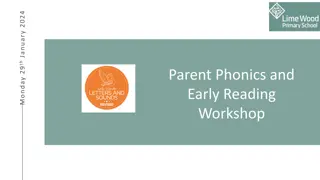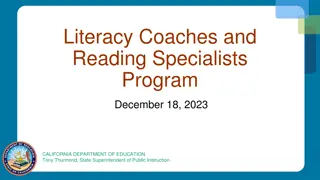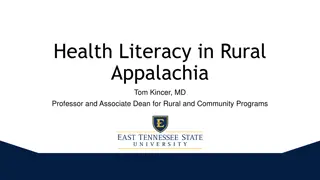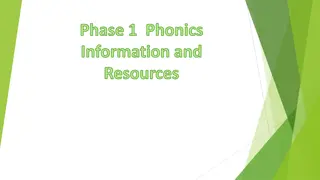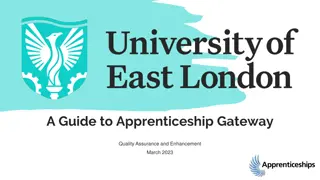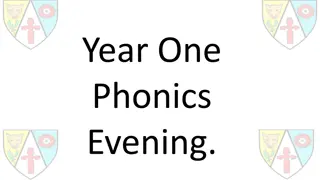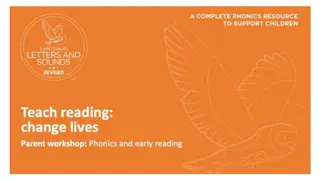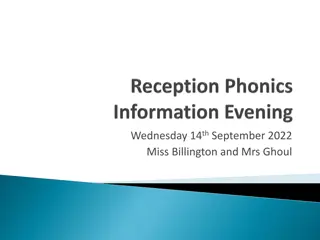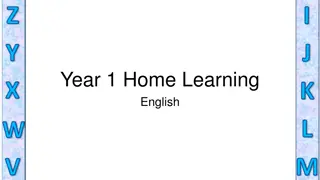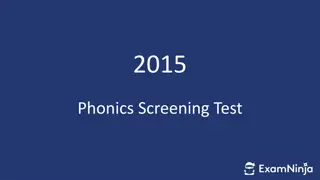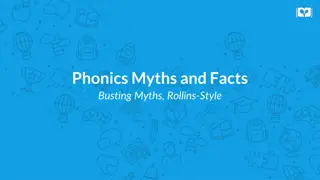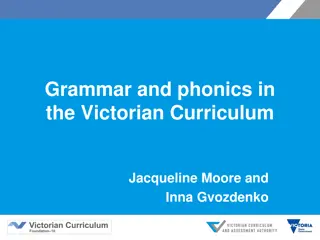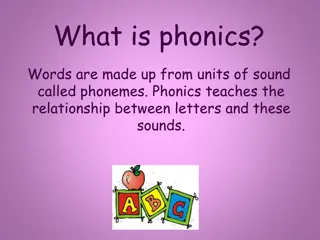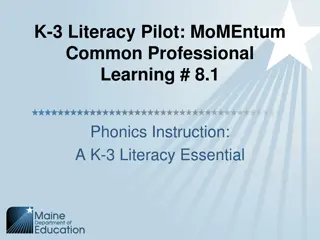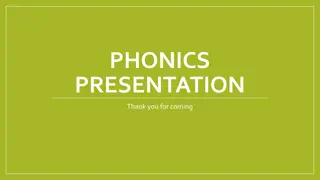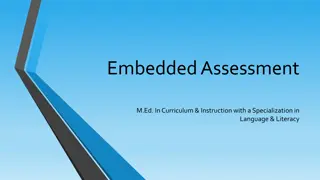Phonics: The Gateway to Literacy Success
Phonics is a vital aspect of reading and writing success, serving as a passport to literacy achievements. This overview delves into teaching phonics at Ashton Keynes, emphasizing the importance of structured approaches like Jolly Phonics and Letters and Sounds. From introducing sounds through stories to blending words, this guide offers insights on supporting children's phonics learning at home and within the school curriculum.
Download Presentation

Please find below an Image/Link to download the presentation.
The content on the website is provided AS IS for your information and personal use only. It may not be sold, licensed, or shared on other websites without obtaining consent from the author.If you encounter any issues during the download, it is possible that the publisher has removed the file from their server.
You are allowed to download the files provided on this website for personal or commercial use, subject to the condition that they are used lawfully. All files are the property of their respective owners.
The content on the website is provided AS IS for your information and personal use only. It may not be sold, licensed, or shared on other websites without obtaining consent from the author.
E N D
Presentation Transcript
Phonics is the gateway to successful reading and writing. A passport to literacy success.
I will be: Giving you a whistle stop tour of phonics! Giving you ways to help support your child at home with phonics and reading. Answering any questions about phonics.
In Class R we teach phonics every morning after play. During each phonics lesson there will be: Whole class teaching in which a new sound or new words are introduced. 2. Independent, play-based phonic activities inside and outside including star challenges! 3. Adult led phonics activities with groups of children. 1.
At Ashton Keynes we teach phonics using a six phase teaching programme called Letters and Sounds. This is a systematic approach which will continue until the end of Year 2. In the Foundation Stage we also use Jolly Phonics to introduce the individual sounds to the children.
Jolly Phonics Jolly phonics is a multi sensory approach to introducing letter sounds. The individual sounds are introduced using a story. Each sound is accompanied by a song and an action. http://t3.gstatic.com/images?q=tbn:ANd9GcR1ishwSTuQ9ekGcRip8nSE_901jBglck2h6tfH0QW-nWW_1L-n
Where we began.... During the first two weeks we continued to develop the phase 1 skills already introduced at preschool. 1. Tuning into sounds 2. Listening and remembering sounds 3. Talking about sounds From week 3 we introduced phase 2: 1. Introducing the first 19 sounds (4 per week ) 2. Blending and segmenting to read and spell VC (vowel consonant) and CVC (consonant vowel consonant) words 3. Reading some High Frequency words and some tricky red words
Although there are 26 letters in the alphabet there are 44 speech sounds in the English language. Pronunciation As soon as children are able to recognise 4 or more sounds, we will encourage them to blend the sounds together to form words. Sound fingers Sound buttons P e t
Sound Fans Your child will have received a sound fan with the sounds we have learnt so far. Please encourage your child to play with the fans and begin to blend the sounds together to create words. Each Friday your child s fan will have new sounds added to it. Please ensure it is kept in their bag at all times.
And then... We will move onto phase 3 whilst continuing to recap and build upon the skills already learnt in phase 2. The children will begin to learn the 25 more complex 2 and 3 letter sounds which will be added to their sound fans. They will be blending one and two syllable words and reading captions and sentences. They will be writing words and captions and practising letter formation skills.
Reading Books Your child will have started bringing home reading books to share with you. Some books will have no words to encourage your child to tell the story themselves. Some books will have simple text which initially you will need to read to your child. You can encourage them to point to the words as you read, spot sounds they recognise and blend very simple words. Gradually they will take over and begin to read themselves.
The reading books are arranged in coloured book band levels and your child will move through the levels at their own speed. Please ensure you sign the reading record book every time you hear your child read. We will hear your child read and change their books once a week. This is done on a rolling weekly rota so please ensure they bring their book bags in every day.
Handwriting As we teach new letters we are also introducing basic letter formation and encouraging all children to have a go at forming some letters. Sometimes in sand, paint, mud, shaving foam as well as on paper. Our school handwriting scheme is based on a cursive formation however we will begin by teaching the children the basic formation first.
How can you support your child at home? Use the sound fans. Read regularly, not just books but signs, logos, magazines... Word books. Practise, practise, practise!
Useful websites: www.jollylearning.co.uk www.phonicsplay.co.uk www.ictgames.com www.oxfordowl.co.uk https://www.youtube.com/watch?v=BqhXUW_v-1s
Useful Apps Teach your monster to read ( 4.99) Computer version - free Jolly Phonics Letter Sounds 4.99 Jolly Phonics lessons 5.99 Jolly phonics songs 2.99




